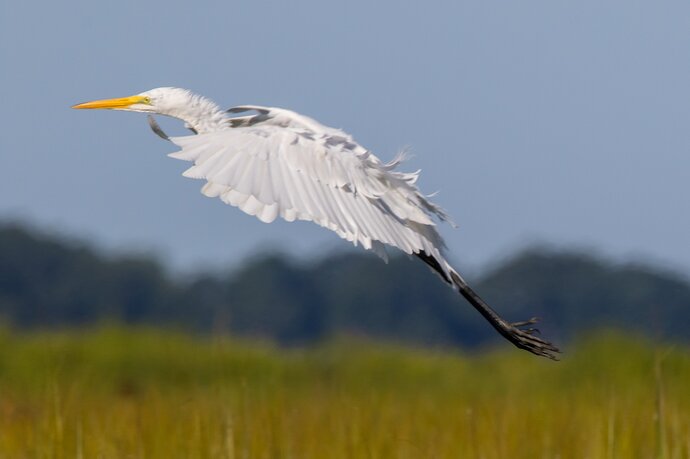Sorry for that last post, one should always proof before posting.
Staying with last summer on Great Island Old Lyme, Ct. This post and the next will show some of the interactions that happened on the island.
This post shows the a take-off and landing. Yes I would have loved to have more space on the left hand side of the frame, but both Egrets were faster than I am. Also the landing Egret’s eye could have been sharper. Both shots are cropped about 20% and I adjusted the highlights, clarity and saturation in Lightroom.
Thank for stopping by.
Peter
What technical feedback would you like if any?
any
What artistic feedback would you like if any?
any
Pertinent technical details or techniques:
Canon EOS 7D Mark II, Shooting Date/Time 08/13/19 08:36:32
Shooting Mode Aperture-Priority AE, Tv(Shutter Speed) 1/1000
Av(Aperture Value) 10, Metering Mode Evaluative Metering
ISO Speed 400, Lens 150-600mm F5-6.3 DG OS HSM | Contemporary 015
Focal Length 600.0mm, Image Quality RAW
(If backgrounds have been removed, etc. please be honest with your techniques to help others learn)
If you would like your image to be eligible for a feature on the NPN Instagram (@NaturePhotoNet), add the tag ‘ig’ and leave your Instagram username below.
I really like the action captured here Peter, as well as your adjustments, look great to me. I especially like the BG in the second image with the layered effect from the grasses, trees, and sky. Yes, maybe a bit more room on the left would be nice. Like you, I have been in this challenging position where you’re tracking a moving bird, especially on a takeoff or landing.
I am wondering if bumping your ISO up to 800 to bring up the shutter speed or maybe even higher to 1600 to maybe also bump your aperture to f/8 would help with the depth of field a tad and sharpness? Under those lighting conditions and the 7DII, you could easily go higher without much compromise. Also, I am also curious about what if any camera support you were using, handheld, tripod, gimbal? It is hard for me to diagnose the lack of sharpness in a shot like this, is it technique ie. support or shutter speed. I know for me, I try to be above 1200 sec for BIF shots.
Pleasing wing and flight position on both images. I agree with Keith on the crop and sharpness issues. My experience with the 150-600 over 550mm shows a significant drop in IQ. By shooting at 550, you really aren’t losing much. That said, Dennis Plank has the same setup as you and he had cleaner images at 600 than I did with mine.
Hi Keith & David
90% if the time I try not to shot at 600mm, staying around 500-550mm. These shots were taken hand-held from my 8ft Puffin rowboat. I used a f/10 setting in hopes of a better depth of field.
Peter
You already received some good feedback. Can’t add much there but…
I don’t know how far you were from the subject, but I just used 75 feet and 100 feet to come up with these values. Using your 7DII and a 600mm lens;
f/10: Near DOF: 74’ 2", Far DOF 75’ 11"
f/7.1: Near DOF 74’ 5", Far DOF 75’ 7"
If you were 100 feet then:
f/10: Near DOF: 98’ 5", Far DOF 101’ 7"
f/7.1: Near DOF 98’ 11", Far DOF 101’ 1"
I see far too many wildlife photographers worrying about DOF and stopping down thinking it will help. The numbers prove it doesn’t matter and only ends up costing you shutter speed and or pushing ISO.
I used 7.1 as it is one full stop wider, hence the twice the shutter speed.
Here’s a screen grab from PhotoPills which has a nice DOF table.
2 Likes
Sorry I missed the f/10! That is really helpful technical information from @Keith_Bauer on DOF! I might experiment with higher shutter speeds, shooting on land, and shooting from your boat, it may be a combination of handholding technique and a bump in shutter speed to nail these types of BIF shots. Looks like you have an amazing location and I am sure the boat really gives you an advantage on your positioning.


